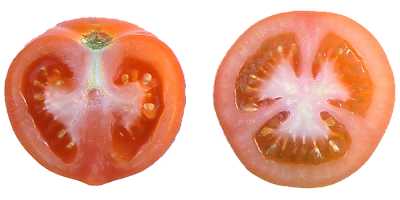Lycopersicon esculentum
(Tomato)
Life
> eukaryotes >
Archaeoplastida > Chloroplastida >
Charophyta > Streptophytina > Plantae (land plants)
> Tracheophyta (vascular plants) > Euphyllophyta > Lignophyta (woody plants)
> Spermatophyta (seed plants) > Angiospermae (flowering
plants) > Eudicotyledons > Core Eudicots > Asterids
> Euasterid I > Order: Solanales > Family: Solanaceae
Tomatoes originate in South America and were domesticated in Mexico. They were
introduced to Europe by the Spaniards in the 1500's and were initially regarded
with grave suspicion because of the reputation of Solanum-like fruit as being
poisonous. Even by 1800, people in northern Europe were anti-tomato whereas in
Spain it had become the most commonly eaten vegetable.

The 10 or so species of Lycopersicon are native to
the western coast of South America from Ecuador to Chile, and the genus also
occurs on the Galapagos Islands. They grow in a desert environment with only
occasional rain and where dew and fog are the main regular sources of moisture.
They can grow as short-lived perennials or as annuals. Vegetable tomatoes were
domesticated from the wild Peruvian Cherry Tomato Lycopersicon esculentum var.
cerasiforme. So the large tomatoes we usually eat these days were derived
from a much smaller cherry tomato.
It seems that domestication of the Tomato did not take
place within its native distribution but in Mexico. It has been suggested that
once agricultural fields became established in Mexico, tomato seeds dispersed
and defecated by birds were able to become established and it was from these
wild tomatoes that Mexicans produced domesticated varieties. It is not
known when domestication of tomatoes occurred - by the time the Spanish
conquered Mexico in 1523, they were already domesticated. The word 'tomato' is
derived from the Spanish 'tomate' which in turn is derived from the Mexican
Nahuatl name 'tomatl' which applied both to the tomato as we know it and the
husk-tomato (genus Physalis).
The Tomato was introduced to Europe by the Spaniards in
the 1500's and was initially regarded with grave suspicion because of the
reputation of Solanum-like fruit as being poisonous. It was also regarded
as an aphrodisiac, and was hence called the Love Apple or Pomme d'Amour. It was
only by about the late 1700s that tomatoes were being grown and eaten in
abundance in Italy and Spain. By 1800 tomatoes had become the most common
vegetables in Spain, they were starting to be eaten in France, while in Northern
Europe they were still regarded with suspicion.
There are now a huge array of tomato varieties, many
developed from an in depth understanding of their genetics. Characteristics that
have been under selection include:
-
fruit size and shape. Size wise,
tomatoes range from the large beef tomatoes down to the small cherry
varieties.
-
disease resistance.
-
increased yield
-
ease of harvesting by machine. For
instance, tomatoes have been developed to stop growing after a certain
number of nodes have been produced so that all plants are uniform when
harvesting takes place.
-
shortening of stigma to within the
anther tube. This has enabled self-pollination thus providing reliable
fruit set. Prior to this, when the style extended beyond the anther tube,
fruit set was dependant on pollination by insects.
-
flavour. There was a time not so
long ago when flavour was not given much consideration and the varieties
were becoming increasingly tasteless but this is changing and some really
tasty new varieties are being produced.
Tomatoes are a prime example of genetically
modified crops and while many of the characteristics being incorporated into new
varieties are harmless health-wise, we need to be on guard about others that
might have long-term insiduous effects we are unaware of.
Herbivores in southern Africa
References
-
Phillips, R. & Rix, M. 1993. Vegetables. Pan Books, London.
-
Sauer, J.D. 1993. Historical geography of
crop plants - a select roster. CRC Press, Boca Raton, Florida.
Text by Hamish Robertson |
